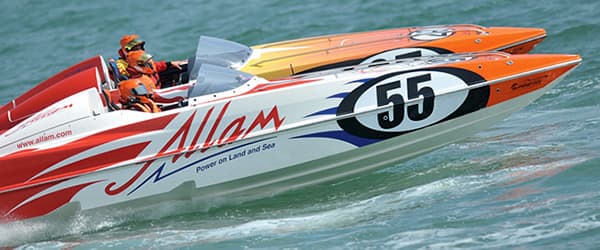Photographing Racing Power Boats: Pictures of Scenery and Speed On The Water

Racing powerboats sometimes disturb the peace and quiet of lakes and rivers with their spectacular action, and this leads to the opportunity for equally impressive sporting action photographs.
Getting the Right Position
The first task is to find a vantage point as close as possible to the action. Paradoxically this can often be on the shore, as officials often strictly police spectator boats. This requires a bit a bit of scouting to find where the boats come close to the shore. Spots near turning buoys offer a range of angles and speeds as the boats change direction.
Follow the Light.
The direction of the light is a critical factor for creating the best images, and available light photographers plan their photography around this. Shooting with the light from behind the subject tends to produce a silhouette of the subject with all the detail in the shadow. With races spread over the day any particular shooting spot only has ideal light for some of the time. This means sometimes packing the gear away even though the action continues on the water.
The Right Camera Equipment
Despite the old adage “it’s the photographer not the camera” as the most important factor in image quality, photographing racing powerboats is one situation where the camera is as important as photographic skill.
The major factor in camera choice is the ability to use a long focal length lens such as the Sigma 135-400mm zoom used in some of the example photos. Lenses of this class are usually large and heavy, impractical for general use, but great for getting the boats to fill the frame. To go with large lenses a monopod is very handy, firstly it steadies the camera minimizing camera shake, and supporting the lens over a long days shooting.
Such lenses require a DSLR camera because of their ability to change lenses. DSLRs have other important characteristics making them suitable for capturing high speed action. Unlike more modest digital cameras, DSLRS are fast with imperceptible shutter lag, fast autofocus systems, and continuous shooting rates for capturing fast unfolding action. The large sensors in DSLRs allow the use of higher ISO settings without noise ruining image quality.
Choosing a DSLR Camera
The main camera for the example photos is a Pentax K10D, demonstrating that good general-purpose DSLR cameras can capture images of sports action. Although ordinary DSLRs are not quite as good as the top specialist sports cameras, the Nikon D3 or Canon D1 Mk111, in terms of fast shooting rates, continuous autofocus and high ISO performance, they can still produce quality images.
Shutter Speed Choice
Despite some misconceptions generally, for sports or action photography slower shutter speeds are preferable, as some motion blur in the image creates an impression of movement. The subject still needs to be sharp, or at least its main part. There is no right shutter speed as it depends on the speed of the boats.
Set the camera to Shutter Speed priority or Tv mode. In this case panning with a shutter speed of 1/250 sec shows some background blur. As the boats enter the turn and present a more head on shot panning is not as effective and faster shutter speeds, say 1/320 or faster more are suitable, even though the boats are slowing down. In the middle of the turns, the slower 1/250 shutter speed becomes suitable as the boats are now going slow enough. These speeds are only a starting point, experiment and practice to find the best for each situation.
Autofocus Settings
Set the autofocus to the continuous mode so the camera refocuses as you track the boat with the camera, usually the shutter button needs to held at the halfway stage. Fast autofocus performance is important for this mode of operation and comes from a combination of the camera system and the lens’ focusing speed.
Lenses with inbuilt high speed focusing motors are generally better than lenses relying on the focus motor in the camera body. Some lenses using the camera focus motor are reasonable performers. The Sigma 135-400 zoom has a lightweight rear focusing system that is faster and quieter than many shorter focal length lenses using the camera body motor.. Sigma replaced this model with a 120-400mm zoom now incorporating a High Speed Motor in the lens.
If your camera and lens combination is a poor autofocus performer, then try focusing manually at a point on the course, and take the picture when the boat arrives in that position.
Plan the Shot
Action photography is full of uncertainty and part of the photographer’s skill is anticipating the likely outcomes. This means having the zoom at the right focal length, exposure settings correct – particularly with an appropriate shutter speed for the action at the point of main interest. This means the sports photographer is ready to shoot and can concentrate on following the action and capturing the decisive moment.
Stick to your plan, the temptation is often to bang away at any action that is peripheral to the main shot and losing concentration on getting one good shot. The result is half a dozen ordinary snap shots. Aim to take fewer shots, but make them all count.